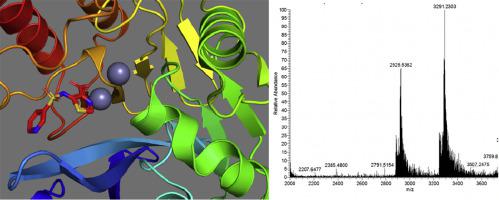Journal of Inorganic Biochemistry ( IF 3.8 ) Pub Date : 2020-06-15 , DOI: 10.1016/j.jinorgbio.2020.111123 Caitlyn A Thomas 1 , Zishuo Cheng 1 , Kundi Yang 1 , Elle Hellwarth 1 , Cole J Yurkiewicz 1 , Faith M Baxter 1 , Sarah A Fullington 1 , Spencer A Klinsky 1 , Jen L Otto 1 , Allie Y Chen 2 , Seth M Cohen 2 , Michael W Crowder 1

|
To probe the mechanism of inhibition of several previously-published metallo-β-lactamase (MBL) inhibitors for the clinically-important MBL Verona integron-encoded metallo-β-lactamase 2 (VIM-2), equilibrium dialyses with metal analyses, native state electrospray ionization mass spectrometry (ESI-MS), and UV–Vis spectrophotometry were utilized. The mechanisms of inhibition were analyzed for ethylenediaminetetraacetic acid (EDTA); dipicolinic acid (DPA) and DPA analogs 6-(1H-tetrazol-5-yl)picolinic acid (1T5PA) and 4-(3-aminophenyl)pyridine-2,6-dicarboxylic acid (3AP-DPA); thiol-containing compounds, 2,3-dimercaprol, thiorphan, captopril, and tiopronin; and 5-(pyridine-3-sulfonamido)-1,3-thiazole-4-carboxylic acid (ANT-431). UV–Vis spectroscopy and native-state ESI-MS results showed the formation of ternary complexes between VIM-2 and 1T5PA, ANT-431, thiorphan, captopril, and tiopronin, while a metal stripping mechanism was shown with VIM-2 and EDTA and DPA. The same approaches were used to show the formation of a ternary complex between New Delhi Metallo-β-lactamase (NDM-1) and ANT-431. The studies presented herein show that most of the inhibitors utilize a similar mechanism of inhibition as previously reported for NDM-1. These studies also demonstrate that native mass spectrometry can be used to probe the mechanism of inhibition at lower enzyme/inhibitor concentrations than has previously been achieved.
中文翻译:

探索各种金属β-内酰胺酶抑制剂VIM-2和NDM-1的抑制机理。
为了探讨几种先前发表的对临床上重要的MBL Verona整合子编码的金属β-内酰胺酶2(VIM-2)的金属β-内酰胺酶(MBL)抑制剂的抑制机理,采用金属分析的平衡透析液,原始状态使用电喷雾电离质谱(ESI-MS)和UV-Vis分光光度法。分析了乙二胺四乙酸(EDTA)的抑制机理;二吡啶甲酸(DPA)和DPA类似物6-(1H-四唑-5-基)吡啶甲酸(1T5PA)和4-(3-氨基苯基)吡啶-2,6-二羧酸(3AP-DPA); 含硫醇的化合物,2,3-二巯基己醇,噻吩,卡托普利和硫普罗宁;和5-(吡啶-3-磺酰胺基)-1,3-噻唑-4-羧酸(ANT-431)。紫外可见光谱和原始状态的ESI-MS结果表明,VIM-2和1T5PA,ANT-431,硫醇,卡托普利和硫普罗宁,而VIM-2,EDTA和DPA则显示出金属剥离机理。使用相同的方法来显示新德里金属β-内酰胺酶(NDM-1)和ANT-431之间的三元复合物的形成。本文介绍的研究表明,大多数抑制剂利用与先前针对NDM-1报道的类似抑制机制。这些研究还表明,天然质谱可用于探测比以前已实现的酶/抑制剂浓度低的抑制机理。本文介绍的研究表明,大多数抑制剂利用与先前针对NDM-1报道的类似抑制机制。这些研究还表明,天然质谱可用于探测比以前已实现的酶/抑制剂浓度低的抑制机理。本文介绍的研究表明,大多数抑制剂利用与先前针对NDM-1报道的相似的抑制机制。这些研究还表明,天然质谱可用于探测比以前已实现的酶/抑制剂浓度低的抑制机理。







































 京公网安备 11010802027423号
京公网安备 11010802027423号